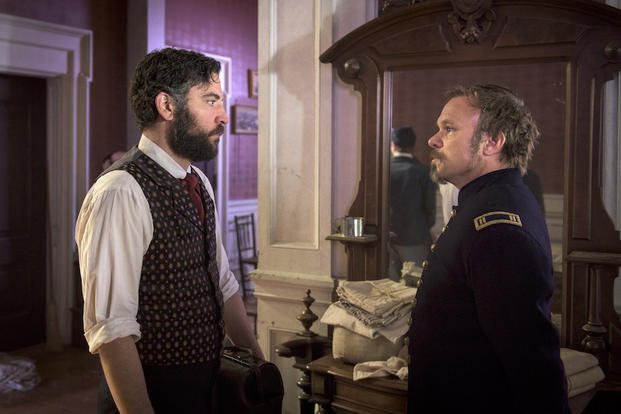This weekend, PBS debuts its first homegrown drama in decades with Mercy Street, a series set in a military hospital during the Civil War. Set in Union-occupied Alexandria, VA, the show chronicles life in a medical ward that cares for both Union and Confederate troops and the trials of the Southern family that owns the hotel that's been commandeered for the hospital facility.
The show stars Josh Radnor (How I Met Your Mother) and Mary Elizabeth Winstead (A Good Day to Die Hard) and features Gary Cole (Talladega Nights). It follows the public television model of portraying both upper class and working class characters and the ways in which their lives cross. Kind of like that Downton Abbey season that saw the estate used as a WWI hospital, except with even more blood and less advanced medical techniques.
We've got a video clip that shows the producers' efforts at historical accuracy and producer Lisa Wolfinger talked to us about the show.
%embed1%

Mercy Street producer Lisa Wolfinger talked to us about making the series.
I can't remember the last time I saw a made in America drama series like this on PBS.
Yes, it is a little unusual. It was a long journey getting here, but thanks to PBS and specifically one woman, Beth Hoppe, who is the Chief of Programming at National PBS, we got this made.
Beth shared my vision for this. She very much wanted to create an original, homegrown American drama. When I came to her with this idea about a Civil War Hospital in Alexandria, Virginia, a border town between North and South. Alexandria was occupied by the Union all four years of the war, so that gave us North and South built in.

The general hospital setting gave us an opportunity to explore Civil War medicine. It was a very dynamic time in American medical history because doctors were pushing the boundaries of medical science. They were faced with mass casualties on an unprecedented scale, so they had no choice. There were huge jumps in medical science during that time.
A couple more elements made it very interesting. This era was the beginning of female nursing. We found the memoirs of some very strong female nurse characters and they were very lively and filled with wit.

Alexandria was a destination point for thousands of escaped slaves heading north to freedom behind Union lines. Once they reached Alexandria, since it was Union occupied, they could stop. They ended up with huge shanty towns around Alexandria.
The final element was the Southern civilians living in Alexandria. We specifically chose the Green family who owned the Grand Luxury Hotel Mansion House. The hotel was turned into a Union hospital by the army at the beginning of the occupation. We knew that that family had stayed in the town throughout those four years, so it gave us a family saga to juxtapose with the medical drama. A lot of different elements came together in this world, in this setting, and it got us very excited.

How much of it is docudrama and how much of it is the writers using historical background and people as jumping off points?
It's a fully dramatized series. But in terms of historical accuracy and our inspiration, just about all the characters are drawn from real people or they’re a composite character based on several different real people. Of course, the setting is real and the place is real, so I would say it's heavily inspired by the historical record. It's inspired by history, but it is drama. Because we're not dealing with iconic figures, we certainly filled in the blanks and wove some of our characters together in a way that maybe we wouldn’t if we were going to be strictly historically accurate.

There’s a lot more blood than most viewers would expect from a PBS drama.
We spent a lot of time making sure that the world feels authentic. We have a whole panel of advisors because there are so many different aspects to our story. We couldn’t find just one generalist, so we have an array of experts. Everybody from James McPherson, who is the preeminent Civil War scholar for military history. We have Shauna Devine, who has written wonderful books about Civil War medicine. We have Audrey Davis, who runs the Black History Museum in Alexandria. We've got Anya Jabour, whose specialty is young women in the Old South.
We wanted to make sure that both the scripts and the world that you see on the screen felt as authentic as possible. So yes, we paid great attention to historical detail, including the surgical scenes. We actually worked with Dr. Stanley Burns, who was Steven Soderbergh's advisor on The Knick as our on-set technical advisor for all our surgical scenes.

The first season’s six episodes feel like a first act of a longer story, a setup for future seasons.
That’s very perceptive. In some ways, the first season is our pilot because we didn’t do a pilot. We wrote all six hours and we shot all six hours as though we were shooting a six-hour film. In many ways, we are introducing our characters and hope to be able to develop those stories in future seasons.
A very important reason for setting it in the hospital was really the ER model. My partner David Zabel was the executive producer on ER and wrote many, many episodes of ER. The ER model is to have a revolving door of patients and bring in new patient stories in every episode.
We really wanted to bring in wounded soldiers and be able to focus on patient stories or soldier stories within the hospital and have the freedom, much like ER, that every episode can focus on a different case and a different story. We’re just starting to play around with that in season one.

For instance we have a young man, Tom Fairfax, who is clearly suffering from battle trauma. In those days, nobody really knew what that was or had a diagnosis or treatment for it. We wanted to explore that and what it would have been like for this young man and I'm sure thousands of other soldiers during the Civil War who suffered from battle trauma. Nobody understood that there was a psychological component to it. They thought it was a cardiac condition.
We wanted to explore themes that are very relevant for veterans today but explore them within the context of the Civil War, putting viewers into that world with the limited understanding and knowledge that they had back then.

The series shows Confederate and Union soldiers receiving treatment in the same hospital. Is that based on history?
Absolutely. The Civil War was very messy and the whole North and South divide thing was a lot messier than we like to portray it nowadays. You certainly ended up with Confederate soldiers in Union hospitals, especially near the front lines.
Alexandria, of course, was near the front line for many prominent battles during the Civil War. So it was not that unusual. We didn’t have to stretch the truth to make that happen. And, obviously, it enhances the drama.




